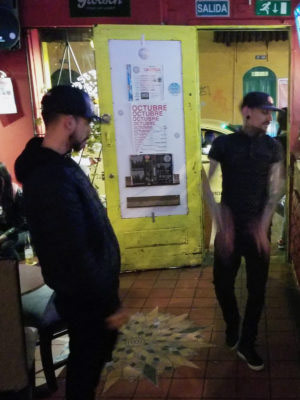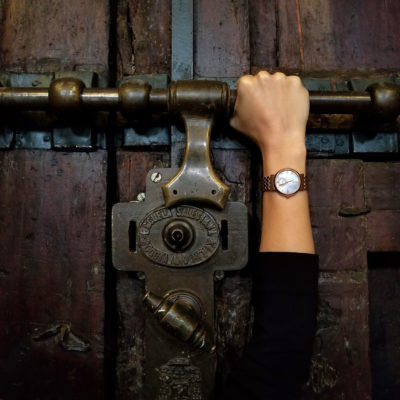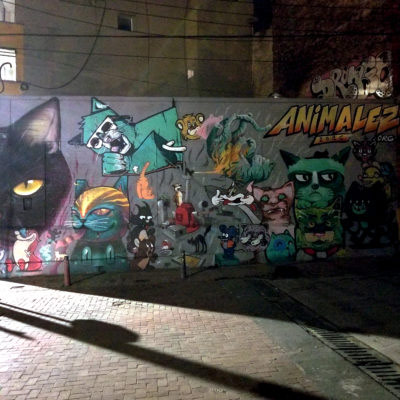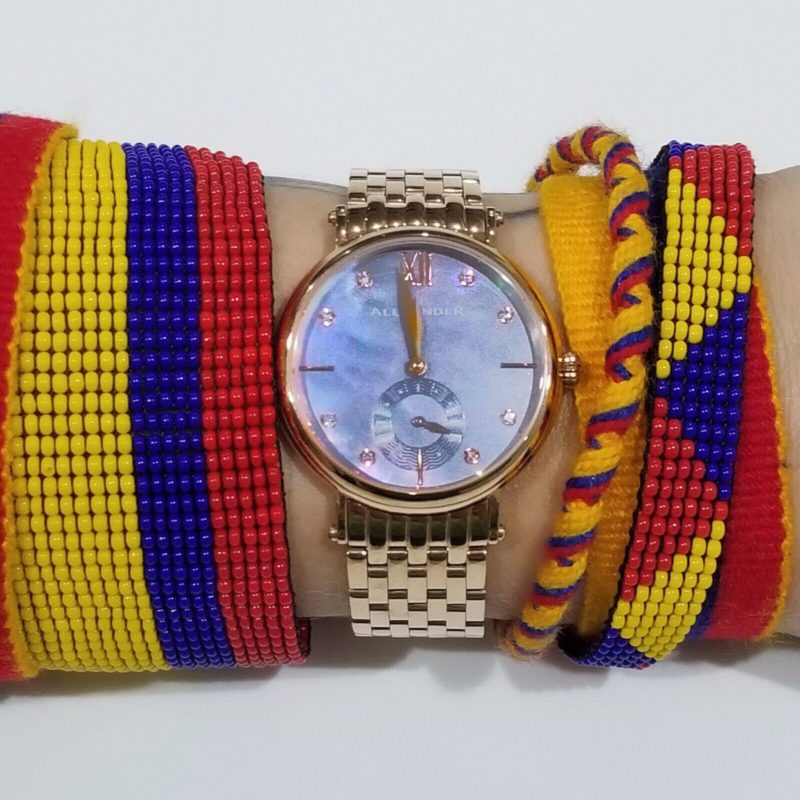Proud and crowded, Bogotá is a whirlwind even with a week to explore. We took our time, anyway, as much as 24 hours in the city allows.
Scooped into a hollow of the Andes, Colombia’s capital is safe in the right places with no-go zones that we encountered anyway.
Stick to La Candelaria to make the most of your time. The historic district is full of nightlife, local cuisine, colonial churches, and world-class street art. We skipped the cable-car ride to Montserrate, because of time, but the moutaintop church is visible from most of the neighborhood.
Follow us @alexander_watches to see more photos of our 24 Hours in Bogotá.🕛12M: Café Rosas
Meld into the culture right away with drinks at Café Rosas. The single bar is small, but well-stocked, and the vibe is real.

We shook off a 3-1/2 hour flight from Miami with a can of Club Colombia and a cocktail, before ducking into a low brick basement. A young crowd in jeans and jackets swayed off-rhythm in slow-motion bliss. A DJ bent over beats between jungle and trap.
We ripped into grins immediately, because we are much too old for Ecstasy, but certainly know it when we see it.
The real fire was back at the bar, where rugged, original hip-hop bumped, obviously influenced by New York’s Golden Age. Tracks stayed raw and flowed deep with melodic hooks and political lyrics in Spanish.
We got lucky meeting the Lakras Bomba crew, who run a skate and music scene. They spit on the spot for us when we asked, led by Andrés Colina aka R.E.X., a Venezuelan transplant and founder of Maguila Records.
We meant to go to bed at a reasonable hour, but we are apparently not as old as we thought.
Street vendors all down the block sell loosies — loose cigarettes — and single-wrap Halls. You’ll be glad you bought at least one of the two.
🕚 11A: La Puerta Falsa
La Puerta Falsa has served tamales, hot chocolate, and other specialty plates to Bogotanos for over 200 years, making it the oldest business in Colombia.
Rumors abound that it’s just a tourist stop now, but the loft was literally packed to the rafters with people who looked like locals in casual clothing with few personal affects.
The loft itself is claustrophobic by today’s standards, and those rafters are splintered and girded by plaster walls now. Sit upstairs anyway.
Order the chocolate completo, which is only completo if you break up the cheese wedge and put in your hot chocolate, like you would put croutons in soup.
Once you’ve drunk your cup, eat the chocolate-soaked cheese. Weird? Maybe. Good? Yup.
🕛 12N: La Catedral Primada and Plaza Bolívar
La Plaza Bolívar, anchored by La Catedral Primada, the Capitol building, and a couple of palaces, is the official center of La Candelaria, about a block down from La Puerta Falsa.

Most Colombian towns have a Plaza Bolívar, named for Simón Bolívar, who helped to establish a number of South American nations independent of Spain.
The one in Bogotá was a significant plaza even in pre-Columbian times, used by the Muisca, an advanced civilization conquered by Spain.
We spent an hour in the early 19th-century cathedral, marveling at saturated marble columns in pink, blue, chestnut, and ivory hues.
In the Plaza, we bought knotted and beaded bracelets.
🕐 1P: Templo de San Francisco
If you ever become jaded about colonial Latin American churches — after all, if you’ve seen one statue of a crying saint under a gold-leaf proscenium arch, you’ve seen them all — visit Templo de San Francisco.
The church was completed in 1611, and its altar and sanctuary gleam golden, three tiers high with dozens of panels and life-size statues gazing out at the nave. A vaulted ceiling features massive timber beams.
Pictures are not allowed during mass, but the opulence leaves a mark, anyway.
🕑 2P: Museo del Oro
During the 16th and 17th centuries, the Muisca legend of El Dorado evolved across the Atlantic.
First, a 16th-century Spanish poet spread word of a man in Quito who knew a man in Bogotá who claimed the king there covered himself in powdered gold. The king was called El Dorado (Bogotá’s airport is, too).
Later, the tales involved ritual sacrifices at lakes or cliffs, using gold and emeralds. Eventually, El Dorado became an entire city of riches, where the king would wear only powdered gold as a suit — the hammered kind was too vulgar for him.
It sounds like a ridiculous game of telephone, until you visit the Museo del Oro.
Room after room of meticulously crafted armor, jewelry, and animal totems in dazzling yellow gold show why the legend was taken seriously for 200 years. The Muisca had serious bling.
The Museo is free on Sundays. If it’s crowded when you go, seek out two items.
The first is the gorgeous conch shell, now disintegrated, but preserved in silhouette by a lost artist who wrapped it in gold foil.
The second is the Muisca raft figure, displayed alone in a dark room, glistening in blazing gold with the king, El Dorado, surrounded by minions, sacrificing riches and who knows what else into a lake.
🕞 3:30P: Govinda’s Loto Azul
Colombia is a wonderful country for vegetarians. In many cities, Hindu centers, often still run by Colombians, offer yoga classes and have vegetarian kitchens that are part-typical restaurant and part-Latin cafetería.
In Bogotá, Govinda’s Loto Azul — or Blue Lotus — offers four meals for lunch. Each comes with a salad bar, a big bowl of soup with grains, and a tall glass of fresh-pressed vegetable juice.
We had the falafel plate and a fava-bean platter. Everything was farm-fresh, portions were giant, and we got out for about $10 U.S. total.
🕟 4:30P: Siesta
After our meal, we decided to take a siesta, the legit Latin American kind where we dozed and ate Yupi Rizadas, a lime-seasoned, ridged potato chip, over two-plus hours. It was glorious, particularly the potato chips.
🕝 7P: Santa Fé
After our siesta, we were curious about seeing other parts of Bogotá, so we thought we’d walk the hour or so through Chapinero, the Brooklyn of Bogotá, and into Zona T, which is perhaps more like South Beach, only without the beach.
We don’t actually know for sure, because our walk turned out to be completely misguided — and, if now, it feels more like an experience, at the time, it felt like a mistake.
So, don’t walk Calle 19 through the Santa Fé neighborhood, unless you are specifically interested in barely functional street lights, crowds of obviously suffering heroin addicts, mentally ill vagrants, knock-kneed packs of prostitutes, and an Uber dead zone.
Oh, and literal garbage fires.
Let’s just say it happened fast enough, we didn’t realize, and then we had gone so far, we assumed we must be almost through — and then we turned around and walked through it again, back to La Candelaria.
Lesson learned: you can do a lot in Bogotá in 24 hours, but not everything.
🕘 9P: La Candelaria Street Art

If you need any proof that Bogotá is a progressive capital, look to its street art. Once an outlaw’s work, outdoor murals are now perfectly legal.
In some cities, legalization dulls the art’s edge — what’s fun about following the rules? — but after cops shot a graffiti artist dead in 2011, Bogotá recapitulated. The city now supports and even commissions street art.
A donation-based tour, started by an Australian artist, is available twice a day in La Candelaria, if you want a guided look.
We wanted to go at night, so we zig-zagged the calles and carreras, walking up hills, crossing streets, and doubling back, turned around amid shuttered windows and tin or tile roofs.
A quick taco stop kept us living, but by midnight, we were propped up on a bench in front of an APC mural of cartoon cats.
The piece is vivid, takes two walls and rounds a corner, but the power had gone out on the block, so it was quiet amid the party clamor of adjacent streets, and it suddenly felt very late.

